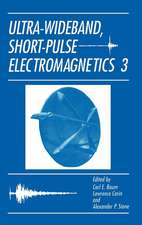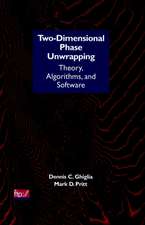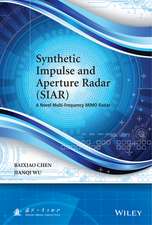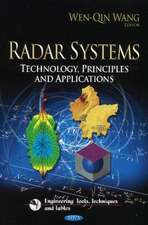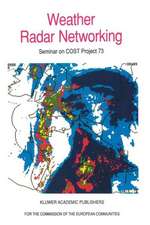Spotlight-Mode Synthetic Aperture Radar: A Signal Processing Approach: A Signal Processing Approach
Autor Charles V. J. Jakowatz, Daniel E. Wahl, Paul H. Eichel, Dennis C. Ghiglia, Paul A. Thompsonen Limba Engleză Paperback – 26 sep 2011
Much of the basic `workings' of synthetic aperture radars is rooted in the concepts of signal processing. Starting with that premise, this book explores in depth the fundamental principles upon which the spotlight mode of SAR imaging is constructed, using almost exclusively the language, concepts, and major building blocks of signal processing.
Spotlight-Mode Synthetic Aperture Radar: A Signal Processing Approach is intended for a variety of audiences. Engineers and scientists working in the field of remote sensing but who do not have experience with SAR imaging will find an easy entrance into what can seem at times a very complicated subject. Experienced radar engineers will find that the book describes several modern areas of SAR processing that they might not have explored previously, e.g. interferometric SAR for change detection and terrain elevation mapping, or modern non-parametric approaches to SAR autofocus. Senior undergraduates (primarily in electrical engineering) who have had courses in digital signal and image processing, but who have had no exposure to SAR could find the book useful in a one-semester course as a reference.
| Toate formatele și edițiile | Preț | Express |
|---|---|---|
| Paperback (1) | 1550.48 lei 6-8 săpt. | |
| Springer Us – 26 sep 2011 | 1550.48 lei 6-8 săpt. | |
| Hardback (1) | 1558.20 lei 6-8 săpt. | |
| Springer Us – 31 ian 1996 | 1558.20 lei 6-8 săpt. |
Preț: 1550.48 lei
Preț vechi: 1890.83 lei
-18% Nou
Puncte Express: 2326
Preț estimativ în valută:
296.72€ • 322.19$ • 249.24£
296.72€ • 322.19$ • 249.24£
Carte tipărită la comandă
Livrare economică 23 aprilie-07 mai
Preluare comenzi: 021 569.72.76
Specificații
ISBN-13: 9781461285731
ISBN-10: 1461285739
Pagini: 444
Ilustrații: XII, 430 p.
Dimensiuni: 155 x 235 x 23 mm
Greutate: 0.62 kg
Ediția:Softcover reprint of the original 1st ed. 1996
Editura: Springer Us
Colecția Springer
Locul publicării:New York, NY, United States
ISBN-10: 1461285739
Pagini: 444
Ilustrații: XII, 430 p.
Dimensiuni: 155 x 235 x 23 mm
Greutate: 0.62 kg
Ediția:Softcover reprint of the original 1st ed. 1996
Editura: Springer Us
Colecția Springer
Locul publicării:New York, NY, United States
Public țintă
ResearchCuprins
1 Range Resolving Techniques.- 1.1 Introduction to Imaging Radars.- 1.2 Range Resolution in Imaging Radars Using CW Pulses.- 1.3 Range Resolution Using Dispersed Waveforms.- References.- 2 A Tomographic Foundation for Spotlight-Mode Sar Imaging.- 2.1 The Cross-Range Resolution Problem.- 2.2 The Concept of Aperture Synthesis as a Solution to the Cross-Range Resolvability Problem.- 2.3 Mathematics of Computerized Axial Tomography (CAT).- 2.4 A Three-Dimensional Tomographic Framework for Spotlight-Mode SAR.- 2.5 The Complex Reconstructed Spotlight-Mode SAR Image.- 2.6 Limitations of the Tomographic Paradigm.- 2.7 Tomographic Development of Bistatic SAR.- References.- 3 Aspects of Spotlight-Mode Image Formation.- 3.1 Introduction.- 3.2 Image Resolution and Area Coverage.- 3.3 Holographic Properties and Multi-look Concepts.- 3.4 Properties of Non-polar-formatted Data.- 3.5 Polar-to-Rectangular Resampling.- 3.6 Fourier Transforms, Aperture Weighting, and Oversampling.- 3.7 Slant-Plane Image Formation and Image Properties.- 3.8 Out-of-Plane Correction and Projection Effects.- 3.9 Ground-Plane Image Formation and Image Properties.- 3.10 Spatial Frequencies, Image Scale Factors, Image Dimensions, Oversampling, and Resolution Summarized.- 3.11 A Typical Image-Formation Procedure.- References.- 4 Phase Errors and Autofocus in Sar Imagery.- 4.1 Introduction.- 4.2 Mathematical Model for Demodulation Inaccuracies.- 4.3 Phase Errors Induced Across the Aperture.- 4.4 Phase Correction using Conventional Approaches.- 4.5 Phase Correction Using PGA.- References.- 5 Interferometric Processing of Sar Data.- 5.1 Introduction.- 5.2 Review of Theoretical Fundamentals.- 5.3 Interferometric Pair Processing: Registration.- 5.4 Interferometric Terrain Mapping.- 5.5 Interferometric Change Detection.- 5.6 Interferometric Terrain Motion Mapping.- 5.7 Stereoscopic Terrain Mapping.- References.- A Rotation Property of Fourier Transforms.- B Phase Analysis for Limitations of the Tomographic Paradigm.- B.l The Phase of the Return from a Point Target.- B.2 The Range Curvature Effect.- B.3 Deramp Residual Phase Error.- C Development of a Practical Image Formation Geometry.- C.l Introduction.- C.2 Imaging Geometry and Coordinate System Development.- C.5 Computing the Shadow Angle (?).- C.7 Computing the Fractional Range and Cross-range Layover Components in the Ground Plane.- C.8 Computing the Slant-Plane Image Shear Angle (?).- C.9 Summary.- D Development of a Synthetic Target Generator.- D.l Introduction.- D.2 Synthetic Target Generator.- E Some Simple Synthetic Target Examples.- E.l Introduction.- E.2 Examples of Synthetically Generated Phase Histories and Imagery.- F ML Phase Estimation and the Cramer-Rao Lower Bound.- F.l Derivation of the Maximum-Likelihood Phase Estimator.- F.2 Estimator Bias.- F.3 The Cramer-Rao Lower Bound.


